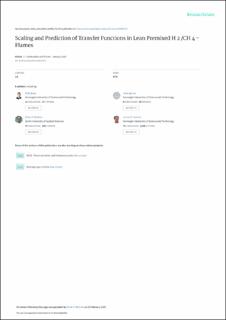| dc.contributor.author | Æsøy, Eirik | |
| dc.contributor.author | Aguilar, Jose | |
| dc.contributor.author | Wiseman, Samuel | |
| dc.contributor.author | Bothien, Mirko R. | |
| dc.contributor.author | Worth, Nicholas | |
| dc.contributor.author | Dawson, James | |
| dc.date.accessioned | 2021-11-03T07:23:38Z | |
| dc.date.available | 2021-11-03T07:23:38Z | |
| dc.date.created | 2020-02-25T15:56:05Z | |
| dc.date.issued | 2020 | |
| dc.identifier.citation | Combustion and Flame. 2020, 215 269-282. | en_US |
| dc.identifier.issn | 0010-2180 | |
| dc.identifier.uri | https://hdl.handle.net/11250/2827399 | |
| dc.description.abstract | Features of the flame transfer function (FTF) are characterized for turbulent, non-swirled, bluff body stabilized “M” flames for different hydrogen and methane blends including pure hydrogen flames. An increase in the cut-off frequency of the FTF is observed for increasing hydrogen concentration. Modulations in the form of peaks and troughs in the gain and the phase were also observed and are shown to be caused by the interaction of two different flow disturbances, acoustic and convective, originating upstream of the flame. The first mechanism is due to the acoustic velocity fluctuations imposed at the base of the flame. A Strouhal number scaling based on the flame height and bulk velocity is shown to collapse the phase slopes and the cut-off frequencies. The second mechanism is shown to be due to vortex shedding from the grub screws used to align the bluff body in the inlet pipe. The associated convective time-delay is used to define a second Strouhal number which collapses the modulations in the gain and phase.
A model is developed that separately considers the impulse response of each mechanism and is interpreted as a distribution of time lags between velocity fluctuations and the unsteady heat release rate. The distributed time lag (DTL) model consists of two distributions that are shown to capture all the features of the FTFs. The distributions show that the acoustic and convective mechanisms behave as a low pass filter and band pass filter, respectively. This results in a band of frequencies where they interact through superposition driving fluctuations of heat release rate. Similar interactions are shown to exist in the forced cold flow revealing that they are of hydrodynamic origin. Further, the band of frequencies are shown to be centered around the natural shedding frequency of the grub screws appearing as peaks in the unforced energy spectra of the velocity at the dump plane.
Finally, a generalized model which takes as an input the bulk velocity, flame height and a geometric parameter is derived assuming a linear dependency of the DTL parameters. The model is shown to predict the behavior of the FTFs relatively well and can potentially be used to analyse regions in the operating conditions map which have not been experimentally tested. | en_US |
| dc.language.iso | eng | en_US |
| dc.publisher | Elsevier | en_US |
| dc.title | Scaling and prediction of transfer functions in lean premixed H2/CH4-flames | en_US |
| dc.type | Journal article | en_US |
| dc.description.version | submittedVersion | en_US |
| dc.rights.holder | This is the authors' manuscript to an article published by Elsevier | en_US |
| dc.source.pagenumber | 269-282 | en_US |
| dc.source.volume | 215 | en_US |
| dc.source.journal | Combustion and Flame | en_US |
| dc.identifier.doi | 10.1016/j.combustflame.2020.01.045 | |
| dc.identifier.cristin | 1797435 | |
| dc.relation.project | Norges forskningsråd: 257579 | en_US |
| cristin.ispublished | true | |
| cristin.fulltext | preprint | |
| cristin.qualitycode | 2 | |
